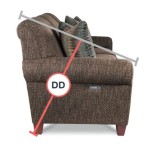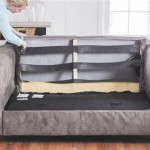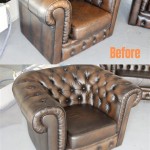How To Remove Felt Tip Pen From Leather Sofa
The accidental marking of a leather sofa with a felt tip pen is a common household mishap. Leather, prized for its durability and aesthetic appeal, poses a challenge when faced with ink stains due to its porous nature and delicate finish. Addressing the stain promptly and utilizing appropriate techniques are crucial to minimize damage and effectively remove the ink. This article provides a comprehensive guide to successfully removing felt tip pen marks from a leather sofa, outlining tested methods and important considerations to maintain the integrity of the leather.
Before initiating any cleaning process, it is imperative to identify the type of leather. Leather sofas are typically made from finished, aniline, or nubuck leather, each requiring a tailored approach. Finished leather, also known as protected leather, has a protective coating that makes it more resistant to stains and easier to clean. Aniline leather, also known as full-grain leather, is dyed through but lacks a protective surface, making it more susceptible to staining. Nubuck leather is top-grain leather that has been buffed to create a soft, velvety texture. Nubuck is the most porous and delicate, demanding very gentle cleaning methods. The care label attached to the sofa often provides information regarding the leather type and recommended cleaning procedures. If the label is unavailable, a discreet test area on the sofa, such as the back or underside, should be used to assess the leather's reaction to different cleaning agents.
Key Point 1: Immediate Action and Mild Solutions
The immediacy of the response to a felt tip pen stain significantly impacts the success of its removal. The longer the ink remains on the leather, the more opportunity it has to penetrate the material, making removal more challenging. As soon as the ink mark is noticed, blot the area gently with a clean, dry cloth. Rubbing the stain can spread the ink and embed it further into the leather fibers. Blotting, instead, lifts the excess ink without forcing it deeper into the material. This initial step is crucial and should be executed with patience and care.
For fresh ink stains, starting with mild solutions is the safest approach. Distilled water is often the first line of defense for finished leather. Dampen a clean microfiber cloth with distilled water and gently blot the stain. Avoid saturating the leather, as excess moisture can cause damage. After blotting, pat the area dry with another clean, dry cloth. Repeat this process several times, observing if the ink begins to lift. If distilled water proves insufficient, move on to slightly stronger, yet still gentle, cleaning agents.
Mild dish soap, diluted with water, can be effective for removing some types of ink from finished leather. Mix a few drops of mild dish soap with a cup of distilled water. Dip a clean microfiber cloth into the solution and wring out any excess liquid. Gently blot the ink stain, working from the outside towards the center to prevent spreading. After blotting, wipe the area with a clean, damp cloth to remove any soap residue. Finally, pat the area dry with a clean, dry cloth. It is essential to use a pH-neutral dish soap to avoid damaging the leather's finish.
Another gentle option is using a leather cleaner specifically designed for leather furniture. These cleaners are formulated to remove stains without stripping the leather's natural oils. Follow the manufacturer's instructions carefully when applying the cleaner. Typically, the cleaner is applied to a clean cloth and gently rubbed onto the stained area. After cleaning, the area is wiped with a clean, damp cloth and then dried. Leather conditioners should be applied after cleaning to restore the leather's moisture and prevent it from drying out and cracking.
Key Point 2: Advanced Cleaning Techniques for Stubborn Stains
When mild solutions fail to remove the felt tip pen stain, more advanced cleaning techniques may be necessary. These methods involve stronger solvents and require careful application to avoid damaging the leather. Before attempting these techniques on the visible area of the sofa, always test the solution on a hidden area to assess its compatibility with the leather.
Isopropyl alcohol, commonly known as rubbing alcohol, is a solvent that can dissolve ink. However, it can also strip the leather of its natural oils and fade its color. Therefore, it should be used sparingly and with caution. Dampen a cotton swab with isopropyl alcohol and gently dab the ink stain. Avoid rubbing, as this can spread the ink and damage the leather. After dabbing, immediately wipe the area with a clean, damp cloth to remove the alcohol residue. Apply a leather conditioner to restore the leather's moisture. This method is best suited for finished leather and should be avoided on aniline and nubuck leather unless absolutely necessary and after thorough testing.
Another option is using a specialized ink remover designed for leather. These products are formulated to break down ink stains without damaging the leather's finish. Follow the manufacturer's instructions carefully when applying the ink remover. Typically, the remover is applied to a clean cloth and gently rubbed onto the stained area. After cleaning, the area is wiped with a clean, damp cloth and then dried. A leather conditioner should be applied to restore the leather's moisture.
For aniline leather, consider using a leather degreaser. Aniline leather is particularly susceptible to absorbing oils, which can make ink stains more difficult to remove. A leather degreaser can help to draw out the oil and ink from the leather fibers. Apply the degreaser according to the manufacturer's instructions, typically by spraying it onto the stain and allowing it to sit for a specified period. After the degreaser has worked, blot the area with a clean cloth and apply a leather conditioner.
For nubuck leather, which is the most delicate type of leather, use a specialized nubuck cleaner and a soft brush. Gently brush the stained area with the nubuck brush to loosen the ink. Then, apply the nubuck cleaner according to the manufacturer's instructions. Blot the area with a clean cloth and allow it to dry completely. After drying, brush the area again to restore the nubuck's velvety texture. Avoid using harsh chemicals or solvents on nubuck leather, as they can permanently damage the finish.
Key Point 3: Prevention and Professional Assistance
Preventing felt tip pen stains is always preferable to attempting to remove them. Taking proactive measures can significantly reduce the likelihood of accidental ink marks on the leather sofa. Keep pens and markers out of reach of children and pets. Designate a specific area for writing and drawing activities, away from the leather furniture. Consider using protective covers or throws on the sofa, especially in high-traffic areas or when children are present.
Regular cleaning and maintenance of the leather sofa can also help to prevent stains from setting in. Dust the sofa regularly with a soft cloth or vacuum with a brush attachment to remove dirt and debris. Condition the leather every few months to keep it moisturized and prevent it from drying out and cracking. Regular conditioning also makes the leather more resistant to stains.
Sometimes, despite best efforts, a felt tip pen stain may prove too difficult to remove with home remedies. In such cases, it is advisable to seek professional assistance from a leather cleaning specialist. Professional leather cleaners have the expertise and specialized equipment to safely and effectively remove stubborn stains without damaging the leather. They can also provide advice on how to care for the leather sofa and prevent future stains.
When consulting a professional cleaner, provide them with as much information as possible about the stain, including the type of ink, the type of leather, and any cleaning attempts that have already been made. This information will help the cleaner to determine the best course of action for removing the stain. Be sure to ask about the cleaner's experience and qualifications, as well as their guarantee for their work.
Ultimately, the successful removal of a felt tip pen stain from a leather sofa depends on prompt action, appropriate cleaning techniques, and a thorough understanding of the leather type. By following the guidelines outlined in this article and exercising caution, it is possible to minimize damage and restore the leather sofa to its original condition.

How To Remove Pen Marks From Leather Sofa The Colour Doctor

How To Remove Pen Marks From Leather Sofa The Colour Doctor

How To Get Pen Marks Off Your Sofa 3 Effective Methods Cover My Furniture
How To Remove Ink From A Leather Couch Howstuffworks

How To Remove Ink From Your Leather

How To Remove Pen Marks From Leather Sofa The Colour Doctor

How To Clean Pen Stains From Leather With White Vinegar Express Co
How To Remove Ink From A Leather Couch Howstuffworks

How To Remove Ink From Leather Bob Vila

3 Ways To Remove Pen Ink From Leather Sofa De Hygienique








